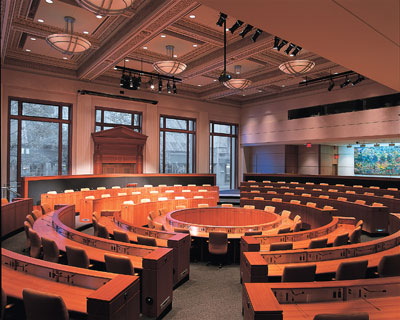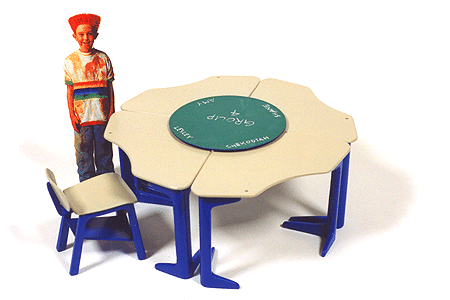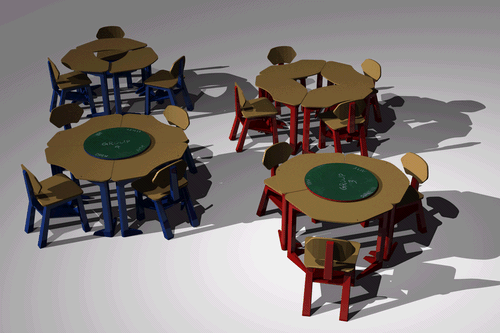
Time: necessary but not sufficient for learning.
The correlation between time-on-task and amount learned is relatively high.
Total time allocated by the school system reduces to a small amount of academic learning time:
* attended time (total time minus days absent)
* academic time (attended time minus recess, lunch hour, etc.)
* engaged time (academic time minus time-off-task)
* academic learning time (engaged time on effective tasks) possibly only one third of total time!
What is the ideal classroom design?
This design is suitable for a large meeting with many speakers. How well does it work for dialogue?

These desks for cooperative learning were designed at the MIT media lab.http://xenia.media.mit.edu/~andyd/mindset/design/clc.html


Terraced lecture theatres are designed for one-way presentation, making cooperative activities very difficult.
Virtual classrooms on the web can be tailored to fit specific learning activities.
![]()
Procedures are the ways that things are commonly done in the classroom. Consistency and regularity are important.
Procedures are established for administration, cleaning-up, and communication. Some middle-school teachers have a weekly class meeting to discuss issues that arise during the week and changes to procedures and rules.
Rules are more simply stated expectations. They are often posted in the classroom.
Teachers should plan incentives at the time procedures and rules are established. Teachers should not wait until a rule is broken to think about consequences.
In general, it is better to reward compliance than punish non-compliance.
Tokens are sometimes used as reinforcers. For example, Scott Creek Middle school in Coquitlam prints Coyote Cash that teachers and supervisors give to students they observe following rules and acting in a socially responsible manner. The Coyote Cash can be redeemed for candy and sundry items.
The Hogwarts house points in the Harry Potter novels also show how tokens are sometimes used (and misused) for reinforcement (and punishment). Middle schools often establish communities like the Gryffindor and Slytherin houses in the Harry Potter novels.
* Explicitly teach rules and procedures at the beginning of term.
* Get organized by planning ahead.
* Identify risks
* View situations from the students' perspective
* Withitness
* Overlapping ("multitasking")
* Group focus
* Movement management (pace and transitions)
Our modern understanding of how to deal with conflicts in the classroom students is strongly influenced by the psychological theories of Carl Rogers (1983).
Roger's concept of empathy underlies the interpersonal skills described here.
* Problem: Parties in a conflict don't listen closely to the other's statements
* Solution: Use active listening and paraphrasing to identify the problem.
In active listening the teacher attends to the verbal and non-verbal content of a student's message, and then summarizes that content.
According to Martin and Sugarman (1993), active listening has three main components:
(1) Physical Attending
(2) Content Responding
(3) Affective Responding (make inferences about the student's feelings)
* If student's problem, then counsel. If your problem, then take action to fix it (confront problem).
"I-messages are teacher statements that clearly label the teacher's emotional reactions as belonging to the teacher, and leave the responsibility for the student's behavior with the student. As a result, such messages avoid the negative impact that accompanies messages in which teachers blame students for their own (that is, the teacher's) experiences...."
-- Martin and Sugarman (1993, p. 25)
An example of a you-message is:
"Gerry, you are talking loudly again. You are making it impossible for others to do their work."
An example of an I-message is:
"Gerry, I find it hard to concentrate on working with other students when you are talking like that."
Use active listening and I-messages to resolve conflicts among students or others.
Have each person involved in a conflict explain their feelings with I-messages, and pay close attention to others with active listening.
Developed by Rudolph Dreikurs, from the psychological theories of Alfred Adler.
Five premises of Adler's theory:
(1) Humans are social beings whose main need is to belong.
(2) The purpose of all behavior is to attain belongingness.
(3) Humans are decision makers, and are responsible for their decisions.
(4) To understand the person we must infer motivations from whole patterns of behavior.
(5) A person's decisions may be based on misperceptions of reality.
The democratic model of teaching advocated by Dreikurs is founded on the concept that teachers should give students the responsibility and freedom to make decisions.
* Natural consequences result from acting in the world.
* Unless the natural consequences may result in harm, teachers and parents should not try to shield the student or child from natural consequences.
* Logical consequences are actions of an adult or other person intended to correct misbehavior.
* Logical consequences are designed so that they are experienced by the child or student as a natural consequence.
* Consequences should be perceived by the student as the result of a decision he or she has intentionally made.
Students may perceive praise as controlling, and as a kind of judgement.
Encouragement values the actor rather than the act.
For example, instead of "That was a smart thing to do," say "You seem to be really interested in thinking about that."
According to Dreikurs, most student misbehavior is motivated by four mistaken goals:
(1) Attention getting (example: "class clown")
Adult feels annoyed.
(2) Power (example: "rebel")
Adult feels threatened.
(3) Revenge (example: "juvenile delinquent")
Adult feels hurt.
(4) Display of Inadequacy -- Avoidance of Failure (example: "complete failure")
Adult feels helpless.
(1) Observe the child and make inferences about goals.
(2) Observe your own reaction to the child's behavior.
(3) Confront the child with possible motives.
"Could it be that you want special attention?"
"Could it be that you want your own way and hope to be boss?"
"Could it be that you want to hurt others as much as you feel hurt by them?"
"Could it be that you want to be left alone?"
(4) Note the recognition reflex.
(5) Apply appropriate corrective action. for example:
If attention getting >> ignore child when making a bid for attention, but give attention for socially appropriate behavior.
If power >> avoid power struggles, channel into socially appropriate channels.
If revenge >>avoid appearing hurt, avoid punishment. Apply encouragement.
If display inadequacy >> make child feel valued, build self esteem.
Dreikurs, R. & Cassel, P. (1972). Discipline without tears. New York: Hawthorne Books.
Martin, J., & Sugarman, J. (1993). Models of Classroom Management. Calgary: Detselig.
Rogers, C. (1983). Freedom to learn for the 80s. Columbus, OH: Merrill.